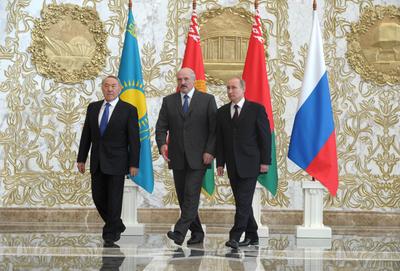At the time, the aim of such a union was to mitigate the deleterious effects of the Soviet Union’s breakdown on the economic interdependence of the newly independent Eurasian countries. The idea gathered pace in 2000 with the establishment of the Eurasian Economic Community (ECC) — the objectives of which were to form a legal framework for a united economic zone, to establish a common energy market, and to enable the free movement of people within the community.
These objectives began to be realised in 2010 with the establishment of a customs union which included Russia, Kazakhstan and Belarus. The customs union eliminated all tariff barriers on trade between member states and established uniform, harmonised tariffs and other trade regulations that applied to countries outside the union.
The principal difference between the customs union and the EEU is that the latter has a broader scope and will include further economic and political integration.
The signing of the agreement comes at a time when relations between Russia and the West are increasingly fraught. The establishment of the EEU follows two decades of Russia’s re-emergence on the world stage after the collapse of the Soviet Union and aims at consolidating Russian influence as a counterweight to the Western powers. This has been seen most clearly in the recent crisis in Ukraine, in which Russia has been at pains to demonstrate to the world that it can actively defend its spheres of interest.
The establishment of the EEU will require a massive undertaking, since as of now it does not stand to comparisons with the European Union, the most successful supranational organisation in history.
Although the EEU includes just three countries it spans a larger geographical area than the EU and borders huge economies in both Europe and Asia, which may give it a potential comparative advantage over the EU in terms of trade.
But a number of other factors cast considerable doubt on the future success of the EEU.
First, the EEU does not represent a relatively large a consumer market; its population is 169 million compared to 507 million in the EU.
Second, the EEU does not have the political and financial institutions necessary for the efficient functioning of consumer markets. Rampant corruption, swollen bureaucracies and excessive state involvement in the economy characterise Russia, the biggest and most influential member of the EEU.
Third, the EU has an advantage over the member countries of the EEU in terms of the structure of its exports. Particularly, exports from the Eurasian customs union are dominated by fuel products. The overall export share of these products was 72.6 per cent in January 2014. In contrast, the three main exports of the EU in 2013 were machinery and transport (40.9 per cent), chemicals and related products (15.8 per cent) and manufactured goods (11.6 per cent). The economic stability, and hence sustainability, of the EEU will be harmed by the lack of diversity in its exports.
Fourth, the recent events in Ukraine have demonstrated the weakness of the Russian economy, the largest in the EEU. Having experienced stagnation in 2013, Russia began 2014 with its annexation of Crimea: this led to massive capital outflows and the political isolation of the country. According to the IMF and the World Bank, the Russian economy has suffered a loss of confidence, and economic sanctions may see the economy contract or experience negligible growth this year. This would negatively affect the prospects of economic growth in Belarus and Kazakhstan, since Russia is their largest trading partner and the driving force behind the EEU.
Russia’s management of the Ukrainian crisis, in particular its breaching of the Budapest Treaty of 1994, brings significant political risks for Belarus and Kazakhstan. Astana and Minsk should be wary about further integration with Russia and its risks and costs for their domestic economies and foreign direct investment.
The prospects of the success of future economic union of Russia, Kazakhstan and Belarus look gloomy. Even with their geographic affinities, the countries of the proposed EEU need economic winds to turn in their favour before a union brings considerable benefits to its members.
Alibek Konkakov is an analyst and Bakhytzhan Kurmanov is chief analyst at the Economic Research Institute in Astana, Kazakhstan.

